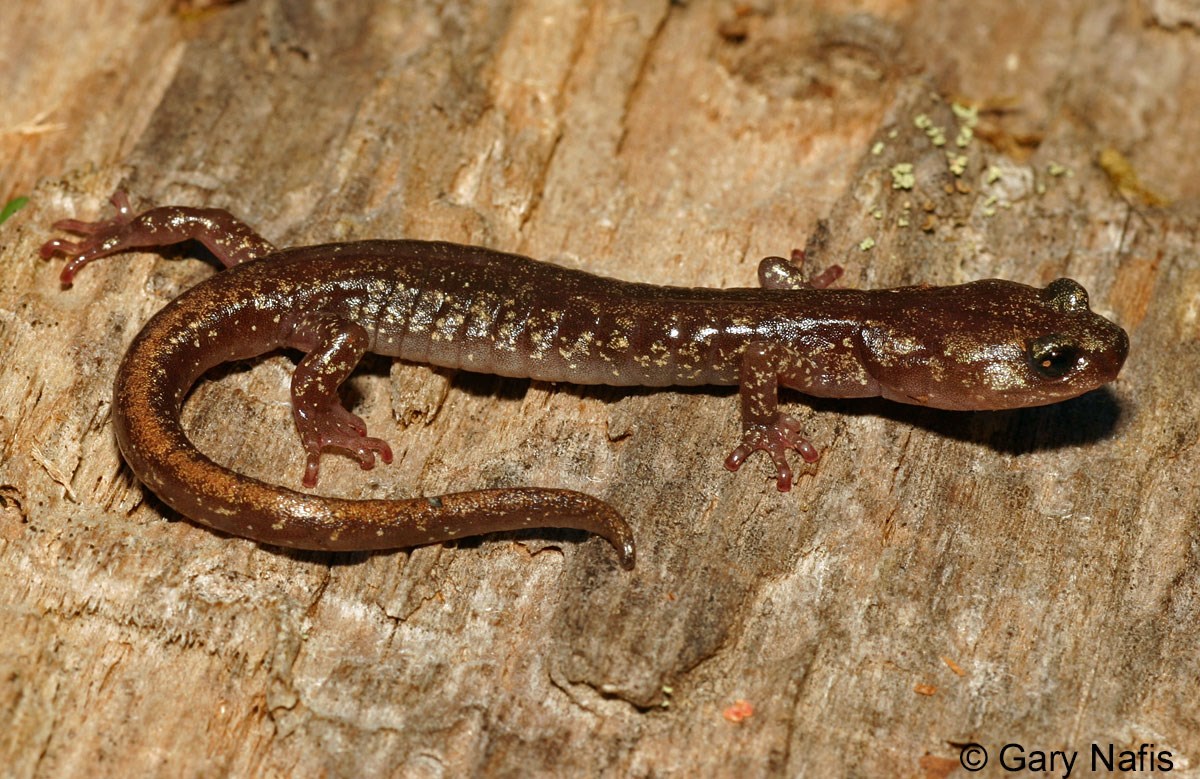Last updated: July 15, 2022
Article
Clouded Salamander

Gary Nafis. CC_BY-NC-ND_3.0
General Description
While many salamanders prefer to live near creeks and under logs, one exceptional species can be found high up in the canopies of trees as well as on the forest floor. The clouded salamander (Aneides ferreus) is one of over 275 species of lungless salamanders in the family, Plethodontidae. It occupies old growth coastal forests throughout Northern California and Oregon.
Distinguishable by its lanky limbs and long fifth toes, the clouded salamander reaches nearly 10 cm (3.85 in) from nose to tail, just longer than a deck of cards. Its underbelly is gray with light flecks, while its back is a subdued brown speckled with brass and clouded with gray, earning the salamander its name. Males are slightly smaller than females and are distinguishable by their triangular head.
Habitat and Distribution
Before 1987, the clouded salamander was thought to range from Sonoma County, California, north through Oregon to the Columbia River. However, chromosomal analysis identified the southernmost salamanders as wandering salamanders (Aneides vagrans). Thus, the range of clouded salamanders was reduced to the area of extreme northwest California through the Klamath Mountains, West Cascades, Willamette Valley, and coastal regions of Oregon.
These salamanders are commonly found at the edges of coastal forests. They are especially abundant in locations with sufficient hiding places and insect prey, preferentially occupying fallen and decaying trees, woody bark litter, and rocky crevices. They can also be found in the forest canopy, as far as 40 m (130 ft) up in trees. In these instances, clouded salamanders co-occur with red tree voles (Arborimus longicaudus), rodents which build nests high in the canopy. Vole nests are warm and damp, and provide excellent habitat for arboreal amphibians. Clouded salamanders have even been found occupying nests alongside red tree voles!
Behavior and Diet
Clouded salamanders are most active at night—nocturnal. During the day they hide under rocks, decaying logs, and leaf litter.
Clouded salamander males are highly territorial and aggressive, often fighting one another over territory. They mark their territory with fecal matter, which other salamanders can identify by smell.
Clouded salamanders are prey to many birds, snakes, and mammals, though they have several strategies to defend themselves. They may remain motionless and camouflaged in the presence of a predator so that they are undetectable, or they may alternate between a series of quick movements and freezes to throw a predator off their path.
As predators themselves, clouded salamanders are invertivores, opportunistically consuming small insects and other invertebrates such as beetles and ants. These creatures hunt by remaining motionless in hiding, then catching prey with their sticky tongue.
Reproduction
Clouded salamanders are polygamous. Courtship among these salamanders begins in the spring, and egg laying commences through early summer. During the mating process, the male produces a pheromone under the mental gland on his chin, rubbing it on the snout of the female. This pheromone attracts the female salamander to mate with him. Once they have paired up, these creatures engage in an elaborate “tail straddle walk,” where the female follows closely behind the male as they march in a circle.
Unlike most salamander species, which lay their eggs under water, clouded salamander eggs are laid on moist surfaces on land in clutches of 8 to 18 under decaying logs or leaf litter. Arboreal nests have been found, though they are not very common. Females are thought to primarily guard the nest, though both sexes have been found in the nest site.
Eggs hatch in early autumn. Hatchlings eat small mites and ants, but tackle larger prey as they grow. Young salamanders are distinguishable from adults by a brassy dorsal stripe extending from their neck to the tip of their tail. Their coloration changes as they mature.
Conservation
The clouded salamander is on the Sensitive Species List for ecoregions in western Oregon. Habitat loss is the greatest threat to this creature. Clear cut logging practices, urban development, and high severity wildfire decimate the old growth forests and abundant woody debris that clouded salamanders rely on.
Fun Facts
- As members of the lungless Plethodontidae family, the clouded salamander breathes through its moist skin (cutaneous respiration) as well as the tissues lining its mouth.
- With the aid of long limbs and a grasping, prehensile tail, clouded salamanders are extraordinary climbers, which explains their occasional presence in the tree canopy. They have also been known to leap short distances, and are able to cling to vertical surfaces.
Where to See
In the Klamath Network, this species occurs at Redwood National and State Parks and Oregon Caves National Monument and Preserve.Learn More

Download a pdf of this article.
Prepared by Maya Smith, Southern Oregon University intern
NPS Klamath Inventory & Monitoring Network
Southern Oregon University
1250 Siskiyou Blvd
Ashland, OR 97520
Featured Creature Edition: July 2022
